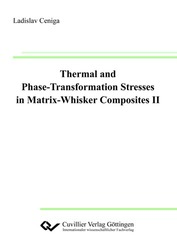| Fachbereiche | |
|---|---|
| Buchreihen (96) |
1378
|
| Nachhaltigkeit |
3
|
| Gesundheitswesen |
1
|
| Geisteswissenschaften |
2362
|
| Naturwissenschaften |
5406
|
| Mathematik | 229 |
| Informatik | 319 |
| Physik | 980 |
| Chemie | 1363 |
| Geowissenschaften | 131 |
| Humanmedizin | 243 |
| Zahn-, Mund- und Kieferheilkunde | 10 |
| Veterinärmedizin | 108 |
| Pharmazie | 147 |
| Biologie | 835 |
| Biochemie, Molekularbiologie, Gentechnologie | 121 |
| Biophysik | 25 |
| Ernährungs- und Haushaltswissenschaften | 45 |
| Land- und Agrarwissenschaften | 1004 |
| Forstwissenschaften | 201 |
| Gartenbauwissenschaft | 20 |
| Umweltforschung, Ökologie und Landespflege | 148 |
| Ingenieurwissenschaften |
1790
|
| Allgemein |
97
|
|
Leitlinien Unfallchirurgie
5. Auflage bestellen |
|
Erweiterte Suche
Thermal and Phase-Transformation Stresses in Matrix-Whisker Composites II
Ladislav Ceniga (Autor)Vorschau
Leseprobe, PDF (16 KB)
Inhaltsverzeichnis, PDF (40 KB)
This book presents original mathematical models for analyzing thermal and phase-transformation stresses in three-component materials. These materials consist of an isotropic matrix, cylindrical particles (whiskers), and a cylindrical envelope around the particles. The stresses are caused by differences in thermal expansion coefficients and crystalline lattice structures during cooling and phase transformation processes.
The models are based on the mechanics of elastic continua and involve:
• A detailed description of the material system’s geometry and parameters, including particle volume fraction, dimensions, and spacing.
• Use of cylindrical coordinate systems to reflect the geometry of the particles.
• Application of Cauchy’s equations, equilibrium equations, and Hooke’s law to derive the stress and strain states.
• Consideration of boundary conditions and the principle of minimum total potential energy to determine valid solutions.
The book also outlines:
• The derivation of differential equations using separation of variables,
• Analytical and numerical procedures for stress computation,
• Final formulas for both thermal and phase-transformation stresses in the matrix and particles.
The presented models are applicable to real materials like martensitic and dual-phase steels, where different phases or grains interact mechanically during thermal or structural changes.
| ISBN-13 (E-Book) | 9783689523688 |
| Buchendformat | A4 |
| Sprache | Englisch |
| Seitenanzahl | 118 |
| Auflage | 1. |
| Erscheinungsort | Göttingen |
| Erscheinungsdatum | 14.10.2025 |
| Allgemeine Einordnung | Sachbuch |
| Fachbereiche |
Angewandte Mathematik
Technische Mechanik, Strömungsmechanik, Thermodynamik |
| Schlagwörter | Thermal stresses, Phase-transformation stresses, Three-component materials, Isotropic matrix, Cylindrical particles (whiskers), Cylindrical envelope, Thermal expansion coefficient, Phase transformation temperature, Crystalline lattice, Elastic continuum mechanics, Cauchy’s equations, Equilibrium equations, Hooke’s law, Minimum total potential energy principle, Boundary conditions, Differential equations, Separation of variables, Numerical modeling, Material system parameters (particle volume fraction, inter-particle distance, particle length, particle radius, envelope dimensions), Martensitic steel, Dual-phase steel, Stress-strain state, Elastic energy, Mathematical modeling of materials, Continuum mechanics, Cylindrical coordinate system, Solid mechanics, Thermische Spannungen, Phasenübergangsspannungen, Dreikomponentenwerkstoffe, isotrope Matrix, zylindrische Partikel (Whisker), Zylindrische Hülle, Wärmeausdehnungskoeffizient, Phasenumwandlungstemperatur, Kristallgitter, Elastische Kontinuumsmechanik, Cauchy-Gleichungen, Gleichgewichtsgleichungen, Hookesches Gesetz, Prinzip der minimalen Gesamtpotenzialenergie, Randbedingungen, Differentialgleichungen, Variablentrennung, Numerische Modellierung, Materialsystemparameter (Partikelvolumenanteil, Partikelabstand, Partikellänge, Partikelradius, Hüllenabmessungen), Martensitischer Stahl, Zweiphasenstahl, Spannungs-Dehnungs-Zustand, Elastische Energie, Mathematische Modellierung von Werkstoffen, Kontinuumsmechanik, Zylindrisches Koordinatensystem, Festkörpermechanik |








